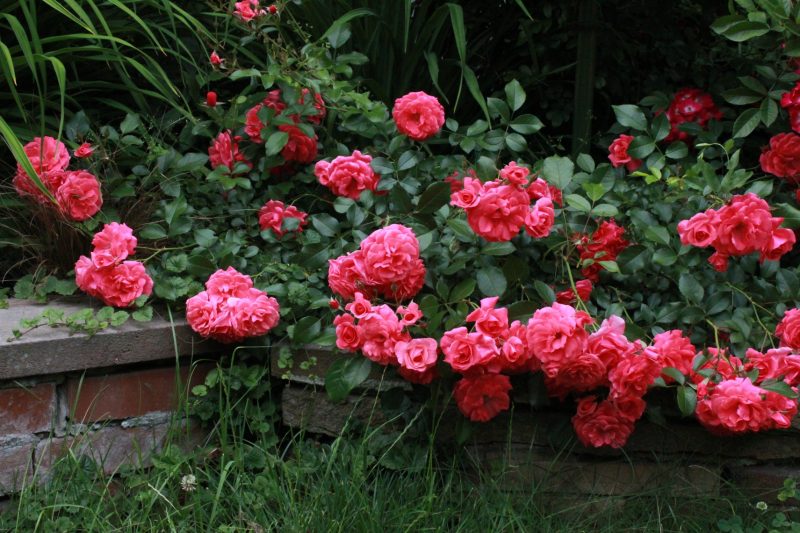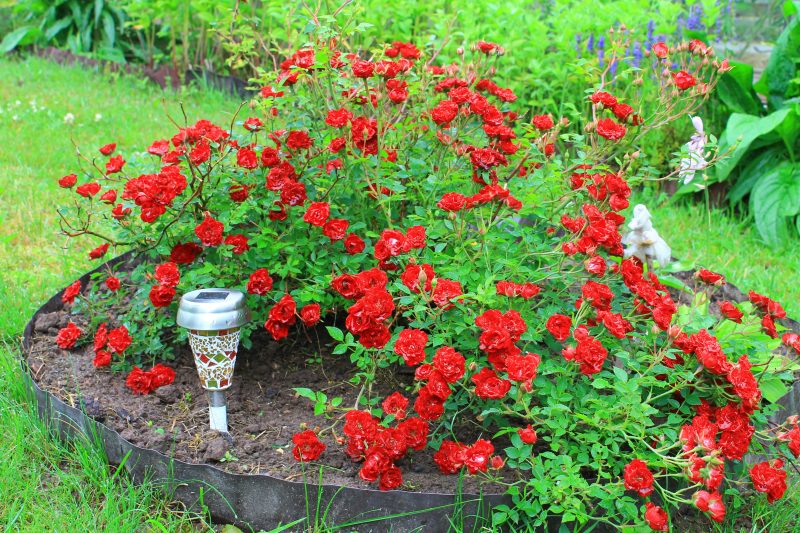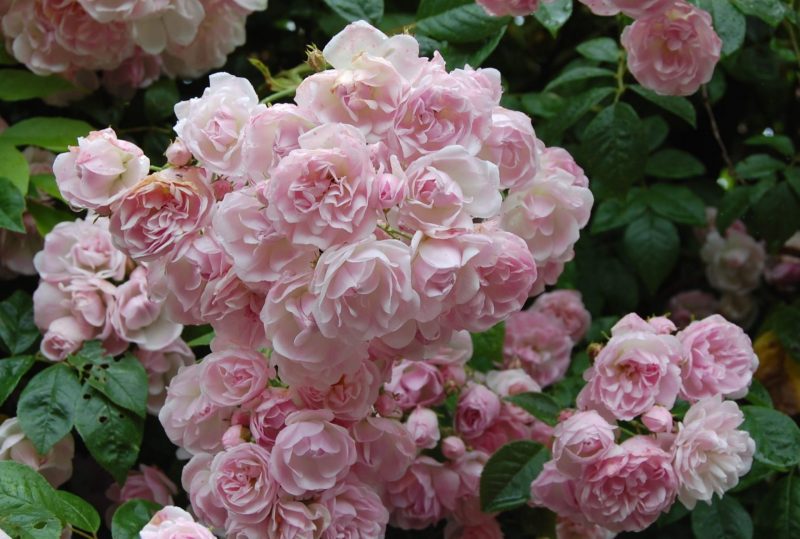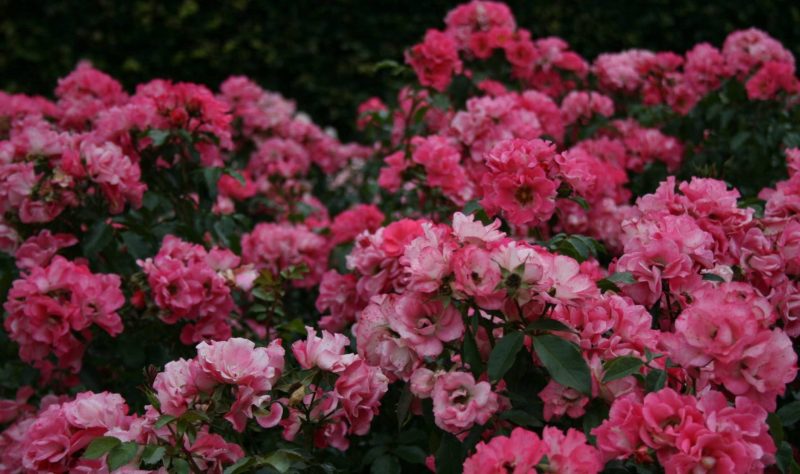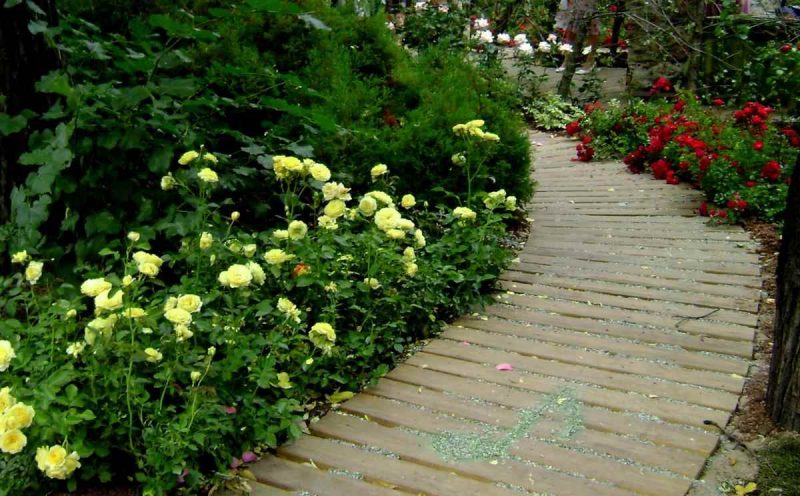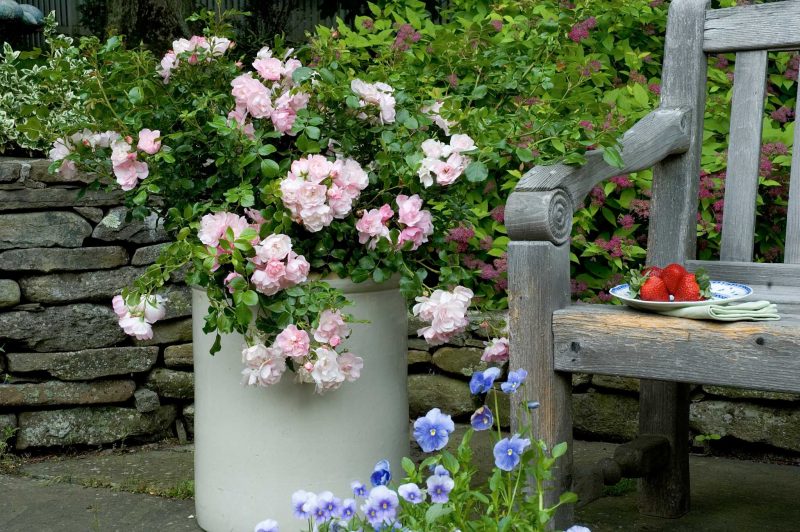Ground cover roses got such an interesting name because their bushes grow much more in width than in height. They seem to cover the soil with their lush and beautiful flowering. These roses are the most unpretentious, but no less beautiful than others. How to choose the right variety, plant a seedling and take care of it, you will learn from the article.
Material Content:
Description of varieties
German nurseries use the following classification of groundcover roses:
- varieties with long creeping branches;
- low, expanding in breadth, branched plants;
- low bushes with creeping branches;
- varieties with flowing branches of an arcuate shape;
- bushes with straight branches, expanding in breadth.
Ground cover roses are distinguished from all other varieties by small leaves and flowers. They hibernate without shelter, are very resistant to disease, rarely affected by insect pests.
Some varieties bloom all summer, others once, but even after flowering they do not lose their decorative effect due to the beautiful glossy foliage.
Popular varieties of groundcover roses:
- "Max Graf" (Max Graf). Non-pink pink flowers with a diameter of 5 cm with a faint aroma. It can be grown as a groundcover and climbing rose. It blooms once, but when other varieties are already finishing flowering.
- Rose Ground Cover "Fairy" (Yellow Fairy). Dense bright yellow flowers bloom in the hands, after a few days they fade to lemon cream tones. A bush of medium height, with arcuately drooping shoots, beautiful.
- "Diamant" (Diamant). Snow-white semi-double flowers are decorated with yellow stamens. They form dense inflorescences resembling magnificent bouquets. Plant height - up to half a meter.
- Rose "Swany" (Swany). One of the best groundcover roses, forms a sprawling bush up to 70 cm tall, abundantly strewn with flowers. White double flowers have a delicate pink tint in the center. The foliage is beautiful, evergreen. Flowering continues throughout the summer.
Basic soil requirements
Roses love light loamy soils with a high humus content. In the sand they grow poorly, overheating in the summer and freezing in the winter. All nutrients from the sand are quickly washed away, and roses have to go hungry.
To improve the sandy soil, non-acidic peat, compost, turf soil, clay are added to it. In areas where plants from the Rosaceae family used to grow for a long time, it is better not to plant roses - the land there is depleted and infected with pathogens. If there is no other place, the soil will have to be completely replaced to a depth of half a meter.
The reaction of the medium in the root-forming layer must be slightly acidic or neutral, otherwise the roses will be inhibited and grow poorly.
Planting roses in the open ground
Seedlings are sold in boxes in garden centers. They can be bought from February to the end of May. The optimal time for planting a plant with sleeping buds is April, when frosts end.
There are two main ways to plant a rose.
The first, classic, is familiar to everyone:
- They dig a hole, fill it with nutritious soil and make a mound of earth at the bottom.
- The prepared seedling is placed on it, the roots are straightened.
- They fill the rose with earth, making sure that the place of budding is 5 cm below the soil level.
- I compact the earth around the seedling, watered with water and mulch the hole.
- Shade the rose or make a greenhouse for it until completely rooted.
The distance between the bushes for medium-sized varieties should be 60 - 70 cm, between dwarf - 50 cm.
The second landing method is called "wet":
- Dig a hole, fill it with water.
- The seedling is placed in the center of the pit, and holding with one hand, with the other, fill the hole with the prepared soil mixture.
- The vaccination site should be 3-5 cm below the soil level.
- Then the seedlings are spudded, watered and mulched, shaded from the sun by spruce branches or non-woven covering material.
They undo the plant when the shoots grow by 5 cm. The seedlings of ground cover roses do not need pruning during planting.
Growing and caring for a groundcover rose
Leaving includes watering and top dressing. Ground-cover roses blooming all summer are not necessary to be pruned - they constantly form new inflorescences even without pruning.
- Freshly planted bushes are watered every 2 to 3 days. Adults - once a week.
- Top dressing is carried out in the same way as for ordinary roses. At the beginning of the season, in the spring, universal fertilizer is applied. Then after 1 month, before budding, a liquid fertilizer for roses. Another feeding with kalimagnesia is done closer to the fall, in August.
- For the prevention of fungal diseases, all cut and fallen leaves are removed from the garden, plant residues are burned, and soil is dug up in the fall.
- In the spring, sanitary pruning of roses is carried out, removing all diseased, dried and broken branches.
- The soil surface under the bushes is mulched so that moisture evaporates less and weeds do not grow.
Plant propagation methods
Varietal roses are usually propagated by vegetative methods. If the plant is root, you can use root offspring for reproduction. Separate them from the uterine bush in spring or late summer, and transplant to a new place.
Other breeding methods:
- rooting of green and lignified cuttings;
- vaccination with an eye and a graft;
- division of the bush;
- layering.
Cuttings are prepared for rooting in the beginning or middle of summer, during the flowering of a rose. Okulirovanie spend at the end of July. Groundcover roses are easily rooted by stem cuttings and layering.
Preparing for the winter
Preparation for winter begins in late August - early September. They begin to gradually reduce the watering of the bushes, make potash and phosphorus fertilizers.Pruning is not done to stop the growth of new shoots. Growing ground cover roses is less time consuming than hybrid tea or climbing, they are frost-resistant and do not need special shelter. The exception is standard specimens.
The main difficulty is to bend the boom to the ground without breaking it. Stubborn plants can be slightly dug up.
The crown of the bush is placed on a spruce spruce branches, on top they cover it with it or with sawdust. Fix the rose in position with iron brackets. If necessary, if the variety is heat-loving, build an air-dry shelter.
Pest and Disease Control
Weakened by diseases, plants hibernate poorly, bloom poorly, and in the absence of help from humans can even die. Therefore, you need to inspect the roses from time to time.
Common diseases:
- gray rot;
- rust;
- powdery mildew;
- black spotting;
- bacterial cancer.
All fungal diseases of the rose are effectively treated with fungicides. Spraying is carried out, noticing the first signs of the disease, as well as in spring and autumn for prevention.
For example, with black spotting, brown or black spots with a light rim form on the leaves. Over time, they merge, causing the death of the leaves. Disputes of the disease spread with the wind. For treatment, the affected bushes and the soil around them are sprayed with a Bordeaux mixture or iron sulphate. Preventive treatment is carried out in April and autumn, before the onset of frost.
Bacterial cancer is not treated with fungicides, a sign of the disease is light growths on the root neck and roots. Over time, they grow and darken, the rose dies. Chemical preparations for this disease do not exist, a diseased plant is dug up and destroyed. In order to prevent, it is recommended to carefully choose seedlings when buying.
Of the pests on the rose, the rosant green aphid, leaf moth, cicada, sawfly, spider mite often settle. All insects are successfully destroyed by insecticides. To control the tick use acaricides.
Use in landscape design
Groundcover roses look spectacular along garden paths, on an alpine hill, as a tapeworm on the lawn. Usually, three bushes of the same variety are planted nearby to enjoy the abundance of flowers all summer. You can plant a crop along the fence, but more lush bushes will bloom in a sunny place. Groundcover roses combine with panicle hydrangeas, delphinium.
Groundcover roses are unpretentious and hardy. Even a beginner grower can master their cultivation. They delight with abundant flowering in response to care and attention, without requiring much time and effort in return.



